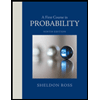Let x be a binomial random variable with n = 20 and p = 28 / 100 Find P (2 ≤ x ≤ 4) and P (x > 1).
Contingency Table
A contingency table can be defined as the visual representation of the relationship between two or more categorical variables that can be evaluated and registered. It is a categorical version of the scatterplot, which is used to investigate the linear relationship between two variables. A contingency table is indeed a type of frequency distribution table that displays two variables at the same time.
Binomial Distribution
Binomial is an algebraic expression of the sum or the difference of two terms. Before knowing about binomial distribution, we must know about the binomial theorem.
Let x be a binomial random variable with n = 20 and p = 28 / 100
Find P (2 ≤ x ≤ 4) and P (x > 1).
Given:
n=20
p=0.28
The binomial probability rule states that the probability of (x) success and (n-x) failures in (n) independent trials of the experiment which has (p) as the probability of success in a single trial is obtained by the formula .
Step by step
Solved in 3 steps




